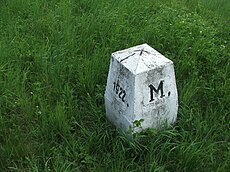Hungary–Romania border
| Hungary–Romania border | |
|---|---|
 Border marker between Hungary and Romania at Csenger | |
| Characteristics | |
| Entities | |
| Length | 448 km (278 mi) |
| History | |
| Established | 1920 Signing of the Treaty of Trianon at the end of the World War I |
| Current shape | 1947 Paris Peace Treaties |
| Treaties | Treaty of Trianon (1920) Second Vienna Award (1940) Paris Peace Treaties (1947) |

The Hungary–Romania border is the state border between Hungary and Romania. It was established in 1920 by an international commission (the "Lord Commission") presided over by geographers including Emmanuel de Martonne and Robert Ficheux,[1] and historians Robert William Seton-Watson and Ernest Denis.[2] The border was set by the Treaty of Trianon which was signed on 4 June 1920.
The border is 448 km (278 mi) long, demarcated by pillars and approximately 20 km (12 mi) of the Mureș/Maros River.
The border has been stable since the end of World War II, and is no longer officially in dispute between the countries.[3]
The Hungary–Romania border is an internal border of the European Union. As of November 2024, Romania is a partial member of the Schengen Zone, so full border checks when crossing by air and sea are not required, unlike crossing by land. The date for opening land borders without border control has yet to be decided.[4]
History
[edit]
Prior to World War I, the eastern and southern Carpathian Mountains formed a natural border between the Austro-Hungarian Empire and Romania.[5]
Hungary and Romania became belligerents in World War I as Romania entered the war in 1916 on the side of the Allies. During that war the part of Transylvania south of the Maros (Mureș) and east of the Szamos (Someș) had been occupied by Romania forces at the time of the cease-fire agreement of Belgrade signed on 13 November 1918.[6] On 1 December 1918, the Great National Assembly of Alba Iulia declared union with the Kingdom of Romania. Subsequently, the Romanian forces moved further into Hungary and occupied Budapest from August to mid-November 1919.[7]
The Treaty of Trianon finalized the armistice between the Allies and Hungary.[8] In the treaty Romania recovered all of Transylvania (including parts of Maramureș, Banat and Crișana),[9][10]

Briefly during World War II, Northern Transylvania (including part of Maramureș and Crișana) was returned to Hungary under the Second Vienna Award in 1940.[11][12] In 1944 as World War II drew to a close and Romania joined the war against Germany, the Allies agreed de facto to the Trianon boundaries, and this was confirmed at the Paris Peace Conference in 1946, and by the subsequent peace treaties formalized in 1947.[12][13]
Geography
[edit]
The Hungarian–Romanian border begins at a tripoint located in the historical region of the Banat, 15 km (9.3 mi) south-east of the Hungarian town of Szeged, where the border between Hungary and Serbia intersects the land border between Romania and Serbia. It generally runs south-south-westwards/north-north-eastwards across the Pannonian Basin to another tripoint located on the Tur river, 16 km (9.9 mi) north of the Romanian town of Satu Mare, where the Hungarian-Ukrainian border intersects the land border between Romania and Ukraine.
Border crossings
[edit]Road
[edit]- Cenad – Kiszombor (<7,5t)
- Nădlac - Nagylak
- Nădlac II - Csanádpalota (motorway)
- Turnu - Battonya
- Vărșand - Gyula
- Salonta - Méhkerék
- Borș - Ártánd
- Borș II - Nagykereki (motorway)
- Săcuieni – Létavértes
- Valea lui Mihai – Nyírábrány
- Urziceni – Vállaj
- Petea – Csengersima
Rail
[edit]All railway crossings are standard gauge. As of June 2019, all railway crossings have passenger traffic.
- Curtici – Lőkösháza, electrified 25 kV 50 Hz
- Salonta – Kötegyán
- Episcopia Bihor – Biharkeresztes
- Valea lui Mihai – Nyírábrány
- Carei – Tiborszállás
See also
[edit]References
[edit]- ^ "In Memoriam Robert Ficheux, francezul care a iubit, cu o fidelitate neasemuită, România". Radio România Iași (in Romanian). 2 August 2021. Retrieved 28 May 2022.
- ^ Lowczyk Olivier, (2010) La fabrique de la paix. Du Comité d'études à la Conférence de la paix, l'élaboration par la France des traités de la Première Guerre mondiale, Paris, Economica, Coll. Bibliothèque stratégique, (in French).
- ^ Linden, Ronald H. (2000). "Putting on Their Sunday Best: Romania, Hungary, and the Puzzle of Peace". International Studies Quarterly. 44 (1): 121–145. doi:10.1111/0020-8833.00151. JSTOR 3013972.
- ^ "Press corner". European Commission - European Commission. Retrieved 3 May 2024.
- ^ Roeder, Carolin F. (2020). "From Neo-Slavism to Internationalism: Interwar Central Europe and the Search for the Lost Mountains" (PDF). Contemporary European History. 29: 16–29, page 22, footnote 28. doi:10.1017/S0960777319000171. S2CID 210545482.
- ^ Krizman, Bogdan (1970). "The Belgrade Armistice of 13 November 1918". The Slavonic and East European Review. 48 (110): 67–87. JSTOR 4206164.
- ^ "Treaty of Trianon". Encyclopedia Britannica. 2020.
- ^ "Treaty of Peace Between The Allied and Associated Powers and Hungary And Protocol and Declaration, Signed at Trianon June 4, 1920". Brigham Young University. Retrieved 3 June 2020.
- ^ Bardócz, Lászlóné; et al. (1998). Történelmi világatlasz [World Atlas of History] (in Hungarian). Budapest: Cartographia. ISBN 963-352-519-5.
- ^ Hupchick, Dennis P.; Cox, Harold E. (2016). "Map 45: Romania after Trianon 1920–1938". The Palgrave Concise Historical Atlas of Eastern Europe. Springer Verlag. pp. 63–64. ISBN 978-1-137-04817-2.
- ^ Ablonczy, Balázs (2011). A visszatért Erdély 1940–1944 [The returned Transylvania 1940–1944] (in Hungarian). Budapest: Jaffa Kiadó. ISBN 978-963-9971-60-8.
- ^ a b Hupchick, Dennis P.; Cox, Harold E. (2016). "Map 46: The Transylvanian Question". The Palgrave Concise Historical Atlas of Eastern Europe. Springer Verlag. pp. 65–66. ISBN 978-1-137-04817-2.
- ^ Vago, Raphael (1989). The Grandchildren of Trianon: Hungary and the Hungarian Minority in the Communist States. Boulder, Colorado: East European Monographs. p. 25. ISBN 978-0-88033-155-5.
